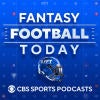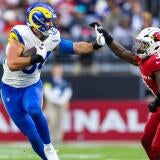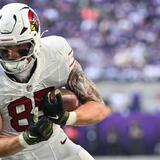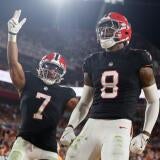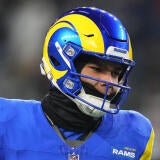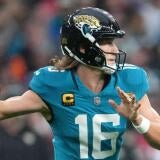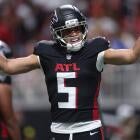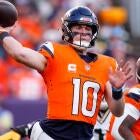2020 Fantasy Football Draft Prep: Ranking the skill position Fantasy pecking order for each NFC team
What to expect from each NFC offense, including who the focal points should be.
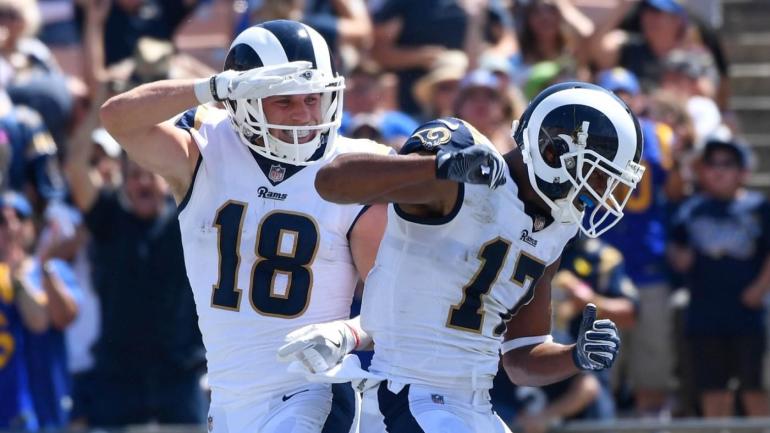
One of the trends we've seen in the NFL in the past several seasons is the blurring of positional designations. Tight ends split out wide far more today than they did 10 or 20 years ago, wide receivers seem to add more rushing production, and running backs have been targeted down the field at a higher (and more effective) rate.
Then there's the consideration of scheme, and how it impacts Fantasy Football. Across the NFL, 11 personnel — one running back, one tight end, and three wide receivers — has overwhelmingly become the most frequent grouping. But there are select teams, like the Eagles last year as a great example, that are employing heavy two-TE formations. While it can feel difficult to trust Dallas Goedert given he's not even the top tight end on his own team, he ran the 15th most routes of any tight end in the league in 2019 … meaning drafting a team's second tight end at his TE15 Average Draft Position in 2020 shouldn't really give you much pause.
This piece is intended to tie those two things together and focus on the team level, applying a "pecking order" of Fantasy production to each NFC team's skill position players. For those of you who are just tuning back into football, hopefully this will help get you up to speed. For those of you locked in all offseason, there should still be some interesting nuggets to consider.
For teams like the Eagles, you will find multiple tight ends higher in the pecking order than you might find any tight end on another roster. Understanding schematic differences and which players are utilized in unique ways is an important part of building a successful draft strategy.
Also keep in mind that not all offenses can support the same number of productive Fantasy options. There are cases where I'm more interested to draft the fourth option in an offense than the second in another. That may be doubly true if we're talking about a player like Mecole Hardman with the Chiefs, who I talked about while reviewing the AFC. While Hardman appears blocked somewhat for playing time, he has the ability to skyrocket in value if a role materializes. Sometimes blocked players in great offenses are the ones with the most upside.
Divisions
NFC East
If the Cowboys are as good offensively as they were in 2019, and importantly if they are as concentrated in their snaps, routes and opportunity shares, this will be one of the deeper Fantasy-relevant pecking orders in the league. In 2019, Cooper, Gallup, Randall Cobb and Jason Witten all saw 83 or more targets, while Jarwin was the only ancillary piece who saw more than 25. Outside those names and Elliott, the entire rest of the Cowboys roster combined for just 64 looks. You would be hard-pressed to find a team that less frequently incorporated rotational players, which is good news for guys like Lamb and Jarwin who may not be as boxed out for targets as their pecking order ranks suggest.
Numbers two through five here might as well be a shrugging emoji, but I'll take Engram as the focal point of the passing game at the underneath depths and Slayton as the downfield play-maker getting the all-important air yards. Slayton also figures to have the biggest chance to make a big step forward as a Year 2 player. To me, there's little reason to draft the 32-year-old Tate, whose range of outcomes seems easily replaced on most waiver wires.
Philadelphia Eagles
I expect Sanders to have a monster year if his recent injury scare turns out to be nothing, but I do want to emphasize Ertz is a pretty huge favorite to lead this team in targets, even as I have concerns he could cede some routes to Goedert. Among tight ends, Ertz ran the second most routes in the NFL last year, and it wouldn't be surprising to see the Eagles give him a few more snaps off in single-TE sets in favor of Goedert. Of course, both figure to play together a ton. Scott remains one of my favorite late-round running backs, and Jackson and Reagor are the best wide receiver bets on this roster. Reagor has a chance to be a rookie star.
Washington Football Team
This list could probably end at McLaurin with the uncertainty behind him, which underscores how many targets McLaurin could see. Peterson figures to lead the backfield early, but I can't imagine he'll see 200-plus touches at 35 years old on a team going nowhere, and Love already got a chance to run with the first team early in camp with Peterson out. But it's the exciting rookie Gibson whose receiving upside gives him the most potential Fantasy relevance; he could also fairly easily not see much of a role at all if someone like J.D. McKissic is involved. Logan Thomas is my favorite super late-round, deep league tight end option this year.
NFC North
You might be surprised to see Cohen over Montgomery here, and it's largely for PPR leagues because targets are so much more valuable than carries. Montgomery will see more touches almost certainly, but in terms of Fantasy-relevance, I've got Cohen's projected role as more valuable. Cohen has 91 and 104 targets in two seasons under Matt Nagy. Robinson and Miller seem to be the clear top downfield pass-catchers and both could post strong target numbers, especially since things are unclear behind them particularly as it pertains to the roles of veterans Jimmy Graham, Ted Ginn and Cordarrelle Patterson.
I like Hockenson as a potential breakout tight end, and if that happens I expect he'll cut into the production of Jones more than Golladay. Swift and Johnson should be a running back duo to watch, and while Swift has the talent and there's discussion of him in a pass-catching role that could equate to monster upside, I'm more of a fan of Johnson at their respective Average Draft Positions.
Jones catches his share of flak, but he's still the clear second option in an offense where identifying the third weapon is a challenge. Dillon and Williams figure to be involved, and Green Bay's moves all offseason suggested a desire to be run-focused. Add in that Adams is such a target-dominant No. 1, and the second receiving option may not have a ton of upside. Still, I'm a big fan of Lazard, and he's my top option to fill that role, ahead of a host of potential other wide receiver contributors including Marquez Valdes-Scantling, Reggie Begelton and Equanimeous St. Brown. I'm pretty much out on Jace Sternberger for these reasons and because Robert Tonyan and Marcedes Lewis could both prevent him from being a full-time tight end.
I've had a hard time getting on board with Thielen's Draft Day cost because he'll be 30 this year and is coming off soft tissue injuries, but it's hard to deny he could dominate the targets in this potentially low-volume offense. Smith closed the gap with Rudolph in snaps and routes late in 2019, and is a second-year breakout candidate if he becomes the No. 1 tight end. There are already positive reports about Minnesota planning to use Smith creatively, and the Vikings should run plenty of two-TE sets regardless.
NFC South
This is a pass-focused offense under Dirk Koetter, and it's Jones and Ridley who should be the centerpieces. There's a valuable role here for Gurley, still, and also Hurst, in what should be a concentrated offense. Whoever wins the No. 3 receiver job, which Russell Gage mostly held down in the slot late last year, could have some value. Smith has the pass-catching leg up on the other No. 2 RB options, and is a deep-league option.
This one seems almost too simple for me, to the point I'm afraid I have it all wrong given a new coaching staff and quarterback. McCaffrey and Moore are almost certainly the top two options in that order, and then it sounds like Samuel will be used a bit more creatively and become the third weapon. Beyond those three, Anderson should have a lock on any downfield targets — and those might be few with Teddy Bridgewater under center but they are valuable — while Thomas is competing for scraps in the short and intermediate areas of the field. I'm not really targeting him among the later-round TE options.
It's next to impossible to decide which of the top two goes first, but I couldn't take the all-time receptions record-holder down a notch on his own team. Still, I expect Kamara to have his first 200-carry season and add his always huge receiving role. He's my No. 3 overall player in PPR formats. The impact those two have is over the past three seasons, no other Saint has hit 75 targets. With Cook posting a strong 2019, Sanders has competition for the No. 3 spot, and it's hard for me to see either being Fantasy stars.
You thought Godwin would be higher than Evans? Look, Godwin is fantastic, but Evans has been a target hog across an underrated six-year career, while Godwin benefited from some impressive efficiency last year. I still like Godwin plenty and do have him ranked higher, but the duo should be close in targets with Evans the easy lead in air yards, so it's hard not to say Evans has the more valuable role. It's also Evans who more frequently winds up a value in drafts. Jones is rising fast, and hopefully the offseason improvement discussions manifest in him maintaining the lead role all year, rather than losing snaps to the veteran McCoy or rookie Vaughn. It's hard to get a read on who will be the No. 3 wide receiver, but I have Scotty Miller over Justin Watson currently. O.J. Howard's role is also hard to define after a down 2019, but there are scenarios where he's Fantasy-relevant in 2020.
NFC West
One could quibble with Hopkins or Drake being the focal point. Kirk looks like the clear third option in an offense I expect to take another step forward in 2020, and he's a big draft target for me — he and Kyler Murray are probably my most-rostered QB-WR stack. Eno Benjamin, Andy Isabella, and Dan Arnold all have outside chances at making an impact.
Kupp and Woods are hard to separate, but I give Kupp the nod on account of his red-zone role and impressive efficiency when playing outside last year — his yards per route run on the perimeter was actually higher than when he was in the slot, so if the Rams move toward more two-TE looks, I don't expect him to take a huge production hit if he's bumped out there more. Higbee is hard one to analyze, and there are definitely scenarios where Everett hurts his production. Josh Reynolds is the likely No. 3 receiver and he could have a surprisingly solid role, but I'm not sure I'm sold on his talent. It wouldn't be surprising if any of the three running backs was the top option, but I agree with ADP that Akers has the edge, followed by Henderson.
It's hard to place Samuel not knowing how much time he'll miss, and it's not much he should be as high as No. 2. Though Mostert sits there now, I'm not drafting him anywhere — he's likely to split early-down work with Coleman, and the buzz around McKinnon as a pass-catching back only further limits Mostert's ceiling. Drafting him is betting on rushing efficiency, something I'm not a fan of. Aiyuk is one of the more underrated rookies in 2020 drafts and he could be a strong rookie contributor.
There's little question in my mind Lockett should be ahead of Metcalf, even recognizing Metcalf's impressive physical profile and strong rookie season, but others see that differently. Carson sounds healthy in his rehab from hip surgery, while Rashaad Penny is likely to miss a significant chunk of the season. Rookie DeeJay Dallas is generating buzz as a third-down option, and if that materializes Carson's role could take a significant hit. He was solid in 2019, but somewhat dependent on some huge snap shares, and Hyde could also impact the early-down work. The tight end situation is extremely hard to parse, and I'm not targeting either Olsen or Dissly though Seattle tight ends have definitely had sporadic Fantasy value with Wilson under center.

